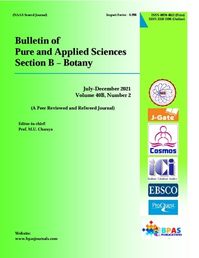Effect of Soil Condition on Pesticide Behavior in Crop Field
DOI:
https://doi.org/10.48165/Keywords:
Persistence, Pesticides, Phytotoxicity, Adsorption, YieldAbstract
The persistence of pesticides in soil is a summation of all the reactions, movements, and degradations affecting these chemicals. Marked differences in persistence are the rule. For example, organophosphate insecticides may last only a few days in soil; the most widely used herbicide, 2,4-D, persists in soil for only two to four weeks; chlorinated hydrocarbons may persist from three to fifteen years or longer. The persistence time of hundreds of other pesticides, are between the extremes cited. The majority of pesticides degrade rapidly enough to prevent buildup in soil. Those that do not do so have potential for environmental damage. In the article authors have studied and discussed the pesticide persistence being directly affected by physical characteristics of soil.
Downloads
References
Adams R.S. Jr., Baker D.G. and Nelson S.E. (1970). Atrazine herbicides interactions in Soybeans, Meeting of Weed Sci. Soc.Amer, Abst. No.-38.
Bailey G.W. and White, J.L. (1964). Review of adsorption and desorption of organic pesticides by soil colloids with implications concerning pesticides bioactivity, J. Agr. Food Chem., 12, 324- 332.
Baumann P.A. and M.G. Merkle, (1979). The effects of soil moisture on the phytotoxicity of diuron, fluridone and triffuralin, Proc. Meeting Sou. Weed Sci. Soc., USA, P.-315 4. Best J.A. and J.B. Weber, 1974, Disappearance of S-triazines as affected by soil pH using a balance-sheet approach, Weed Sci., 22, 364-373.
Best, J. A., Weber, J. B. and Monaco, T. J. (1975). Influence of Soil pH on s-Triazine Availability to Plants. Weed Science, 23(5), 378-382. Retrieved December 7, 2020, from http://www.jstor.org/stable/4042341
Corbin, F.T., Upchurch R.P. and Selmen, F.L. (1971). Influence of pH on the phytotoxicity of herbicides in soil, Weed Sci., 19(3), 233-239.
Green R.E. and Obien, S.R. (1969). Herbicides equilibrium in relation to soil water content, Weed Sci., 18, 514-519
Grover, R. (1968). Influence of soil properties on the phytotoxicity of 4-amino-3,5,6-trichloro picolinic acid, Weed Res., 8: 226-232
Hance R.J. (1967). The speed of attainment of sorption equilibria in some systems involving herbicides, Weed Res., 7, 29-33
Harris, C.I. and G.F. Warren, (1964). Adsorption and desorption of herbicides by soil, Weeds;
: 120-126.
Harrison G.W., Weber J.B. and Baird J.W. (1976). Herbicides phytotoxicity as affected by
selected properties of North Carolina Soils, Weed Sci., 24, 120-126
McWhorter, C.G. and Wills, G.D (1978). Factors affecting the translocation of C-mefluidide in
soybeans (Glycine max) and common cocklebur (Xantbium pensylvanicum).Weed Sci., 26, (5),
-440.
Pallas, J. E. (1960). Effects of temperature and humidity on foliar absorption and translocation
of 2,4-dichlorophenoxy- acetic acid and benzoic acid. Plant Physiol Sep., 35(5), 575–580.
Rust R.H., Adams R.S. Jr. and Martin W.P. (1972). Developing a soil quality index, In :
Indicators of environmental quality, Plenum Press, New York, 243-247
